
Planning a Joshua Tree day trip and wondering what to do and see? From the best hikes, views, and more, here are all the things you must add to your one day in Joshua Tree itinerary!
With a magical desert landscape dotted with the namesake Joshua trees, cholla cactuses, and interesting rock formations, Joshua Tree is a haven for outdoor enthusiasts and explorers. Just a few hours from Los Angeles, Orange County, and San Diego, a Joshua Tree day trip is a must for anyone who is looking to escape the hustle and bustle of the city.
Joshua Tree National Park looks otherworldly, almost as if you’ve stepped into a Dr. Seuss wonderland.
I first visited Joshua Tree National Park as part of a weekend getaway in Palm Springs, and although I only spent a couple of hours in the park (it was over 100 degrees that day), I was blown away by the unique landscape and vowed that I would return again to spend more time in the park.
I finally made my return trip a few years later, spending 1 day in Joshua Tree while visiting my boyfriend in Orange County, while I was living in San Francisco. It was just as beautiful as I’d remembered it (and it helped that we visited in March, when the temperatures are much cooler and more suitable for exploring).
There are so many opportunities for hiking, rock climbing, stargazing, and photography within the park, that it is an absolute must on any California bucket list. Even though the park draws over 2.5 million visitors a year, because of the vast desert landscape (the park sprawls over 1235 square miles), it sometimes even feels like you have parts of the park all to yourself.
There are 12 self-guided nature walks within the park, as well as a variety of hiking trails, boulders suitable for climbing, viewpoints, and more. Even if trying to see Joshua Tree in one day, there is so much you can see and do!
Wondering what to do and see on your day trip to Joshua Tree National Park? Here are all the things to check out on your Joshua Tree one day itinerary!
Disclosure: This post contains affiliate links. This means that if you make a purchase or booking, I may receive a small commission at no additional cost to you. Pictures & Words is a participant in the Amazon Services LLC Associates Program, an affiliate advertising program designed to provide a means for us to earn fees by linking to amazon.com and affiliated sites at no cost to you.

About Joshua Tree National Park
Joshua Tree National Park is situated at the point where the Colorado Desert and Mojave Desert meet, each with their own distinct climate and species.
Therefore, you will see two distinct landscapes in the park – the Mojave Desert stands higher in elevation with a cooler climate, and is home to the whimsical namesake Joshua trees; they live in close proximity to the Cholla cactus, native to the Colorado Desert.
Actually, the Joshua “trees” aren’t actually trees at all – they’re technically succulents! Officially known as the Yucca brevifolia, they are a unique variety of the agave plant (yes, the kind used to make tequila!). Aside from the Mojave Desert, you can also find them in the Sonoran Desert (in Arizona), and the San Bernardino Mountains. You can even spot them on the way to Death Valley, and even right outside of Las Vegas.
The unique plants are a vital part of the desert ecosystem, with many species, including birds, mammals, and insects (even lizards) living in the area. They were important to the native Cahuilla people who once occupied the area, who recognized their useful properties.
So where did these guys get named “Joshua Trees”? Mormon settlers gave the trees their name when they observed that its twisted, curvy shape reminded them of the Old Testament figure Joshua lifting his hands in prayer.
Can You Do Joshua Tree in a Day?
YES!! Even with only a day in Joshua Tree National Park, you’ll get to see its main highlights, go on a few short nature walks, and admire all of the unique scenery in the park.
We ended up spending 6 hours in the park, including a leisurely picnic lunch break , and plenty of stops for photos.
If you want to do more hiking, add extra time to your Joshua Tree one day itinerary. If you are pressed for time, you can probably complete this exact itinerary in 4-5 hours if you leave off the extra photo stops and lunch break.
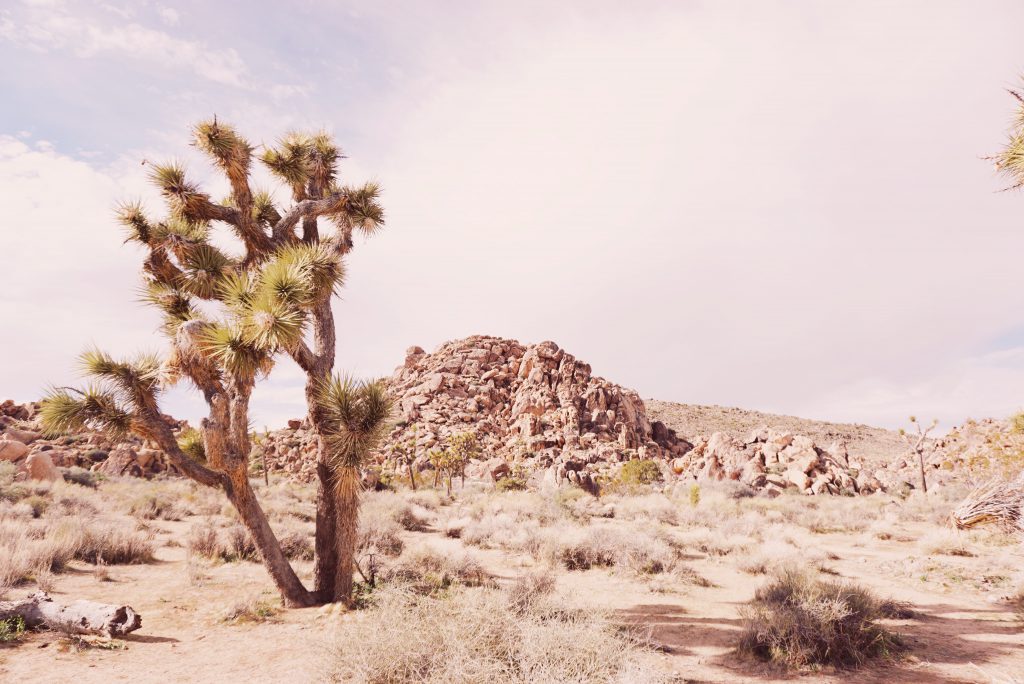
When is the Best Time to Visit Joshua Tree National Park?
Joshua Tree gets hot in the summer months, and cold in the winter. It stays relatively clear and dry year-round. Average temperatures range from 35-99 degrees Fahrenheit (2-37 degrees Celsius) over the course of the year – it rarely falls below 28 degrees Fahrenheit (-2 degrees Celsius) or above 105 degrees Fahrenheit (40 degrees Celsius).
The park’s high season is during the months of March-May and October-November. This are the best months to visit, as it’s when the temperatures are most comfortable (with temperatures staying in the 70s-80s degrees Fahrenheit range) and most appropriate for hiking and other outdoor activities.
Spring in Joshua Tree National Park
Spring is an especially popular time to visit, as the park landscape becomes beautifully transformed as the colorful wildflowers bloom (such as the California poppy). The second time I came to Joshua Tree, I visited in the beginning of March and it was the perfect time to visit – the wildflowers were just starting to bloom, and the weather was comfortable (highs in the mid 60s Fahrenheit).
It did start getting a bit windy and chilly as the day went on, so be sure to dress in layers and bring a jacket!
As such, the park is most crowded during these months and this is when you will encounter the most of the park’s annual 2.5 million visitors, drawing over 150,000 monthly visitors (compared to only 60,000-70,000 monthly visitors during summer).
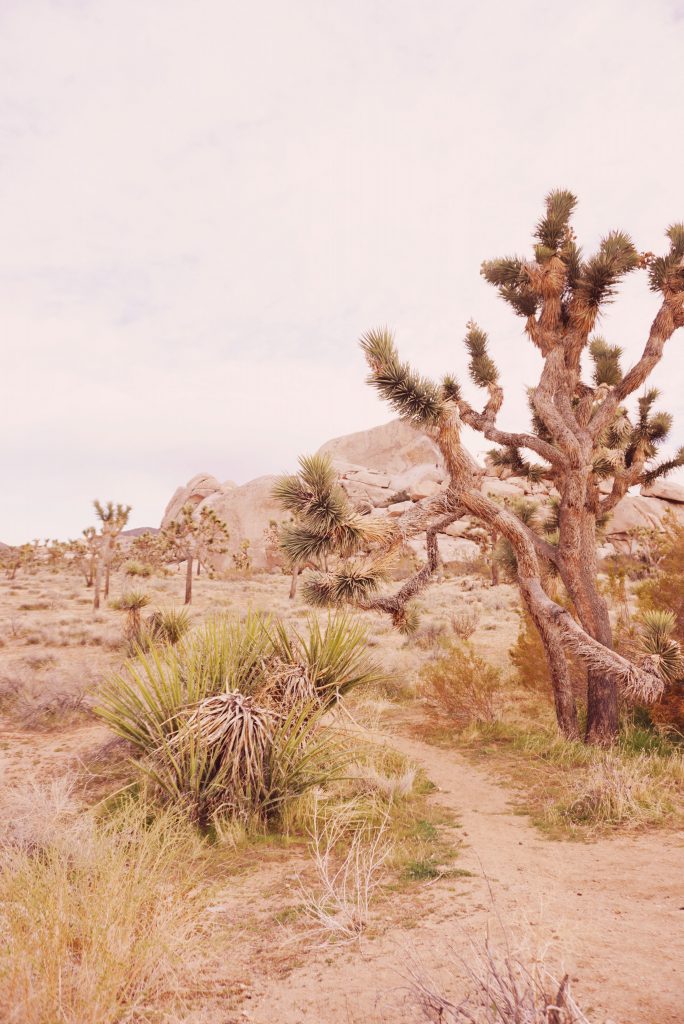

This is also when accommodations are priced higher and campground reservations booked up quickly – you must book weeks, sometimes months in advance! We ended up only doing a Joshua Tree National Park day trip instead of a weekend trip because we found that most accommodations and campgrounds were booked up when we tried to plan our trip just two weeks in advance.

Summer in Joshua Tree National Park
Summers are sweltering in Joshua Tree, but you will see the least amount of crowds (because DUH, it is HOT). I visited the park as a quick stop on a weekend in Palm Springs, and it almost felt like we had the entire park to myself!
Yes, it is hot AF and you will be sweating balls…and no, you will not do any hiking (we just drove through and made a few quick stops and then bounced). But you will find that the higher elevations within the park are a bit cooler – and I found that it was a full 10 degrees cooler than in Palm Springs, so it almost felt like a respite in that sense!
If you do visit in summer, bring PLENTY of water and do not do any hiking in the middle of the day. It’s just way too hot. Highs can reach up to 115 degrees and it’s not safe – heat stroke and dehydration are no joke!
Those who want to do some stargazing may enjoy visiting in summer – it’s the best time to see the Milky Way from the park!
Fall in Joshua Tree National Park
Fall is also an excellent time to plan a day trip to Joshua Tree – the summer heat finally cools off, temperatures are comfortable again, and it’s before the cold rolls in.
It’s also the start of climbing season in the park.
Winter in Joshua Tree National Park
You can also choose to plan your Joshua Tree National Park day trip in the winter, when average highs hover around the high 50s-low 60s Fahrenheit (around 16-17 degrees Celsius). However, temperatures drop quickly as it gets later in the day, and lows often fall close to or below freezing.
Snowfall is rare in the park, however, if you happen to time your day trip to Joshua Tree with the snow, it is an absolutely magical sight – it looks like a completely different planet!
How can you beat crowds in Joshua Tree?
Joshua Tree can get super crowded, especially on weekends during the spring and fall. So what can you do avoid the crowds in the park (without visiting in the summer, when it is virtually empty)?
My suggestion – come early! This is the best strategy when visiting all kinds of popular places. Even during peak times, you can avoid most of the crowds by getting an early start and visiting early in the morning – some of the park’s attractions as supposed to be especially magical at sunrise to make it worth it!
Also consider visiting on a weekday.
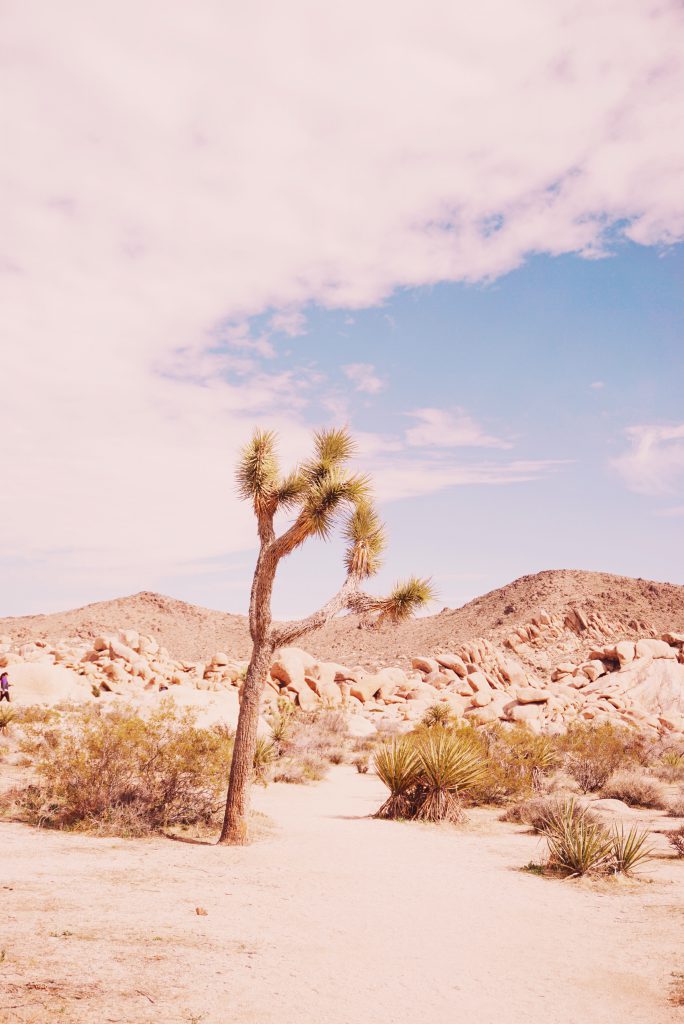

How to Get to Joshua Tree National Park
Joshua Tree National Park is located just a few hours’ drive from many destinations in Southern California, making it an easy day trip from Los Angeles, Orange County, or San Diego.
Driving distances below:
- From Los Angeles: 131 miles (~2 hours, 15 minutes)
- From Long Beach: 138 miles (~2 ½ hours)
- From Santa Ana: 117 miles (~2 hours, 15 minutes)
- From Palm Springs: 37 miles (~50 minutes)
- From Ontario: 71 miles (~1 hour, 15 minutes)
- From San Diego: 164 miles (~2 hours, 45 minutes)
The closest airport is located in Palm Springs (PSP), which is served by 10 major airlines, including American, Delta, United, and Alaska. However, many flights to Palm Springs only operate on a seasonal basis, which means that there may not be flights available if you visit during the slow summer months.
The closest major international airport is Los Angeles International Airport (LAX) – from here, you can fly to and from almost anywhere in the world. LAX also usually has the cheapest flights and is also served by all major car rental agencies, including Enterprise, Hertz, National, Budget, Thrifty, Alamo, and many others.
One thing to note is that LAX is BUSY – you’ll encounter lots of traffic just trying to get out of the airport, in addition to any traffic you may encounter as you make your way to Joshua Tree.

Another option is to fly into Ontario International Airport (ONT), which offers flights to many destinations in the United States, as well as Mexico and China. I found that flights are cheaper and more plentiful than to Palm Springs, but the airport is far less chaotic than LAX. Plus, I found that car rental rates are cheaper from the Ontario airport – we rented a car for just $30/day through Hotwire!
Other airport options include John Wayne Airport in Santa Ana (SNA), Long Beach Airport (LGB), which serves primarily JetBlue, and San Diego International Airport (SAN).
One thing to note is that traffic can be crazy on the way to Joshua Tree, especially from the Los Angeles and Orange County areas – be sure to factor in plenty of extra time to account for traffic on your Joshua Tree 1 day itinerary!
We drove from south Orange County on a Saturday morning, and ended up encountering plenty of traffic on the way to the park, and got a later start on our Joshua Tree one day itinerary than we had anticipated.
I highly recommend leaving for your day trip to Joshua Tree as early as early as possible, especially on the weekends and to allow at least an extra hour to account for any traffic on the way (hey, you’ve got limited time when trying to see Joshua Tree in a day)!
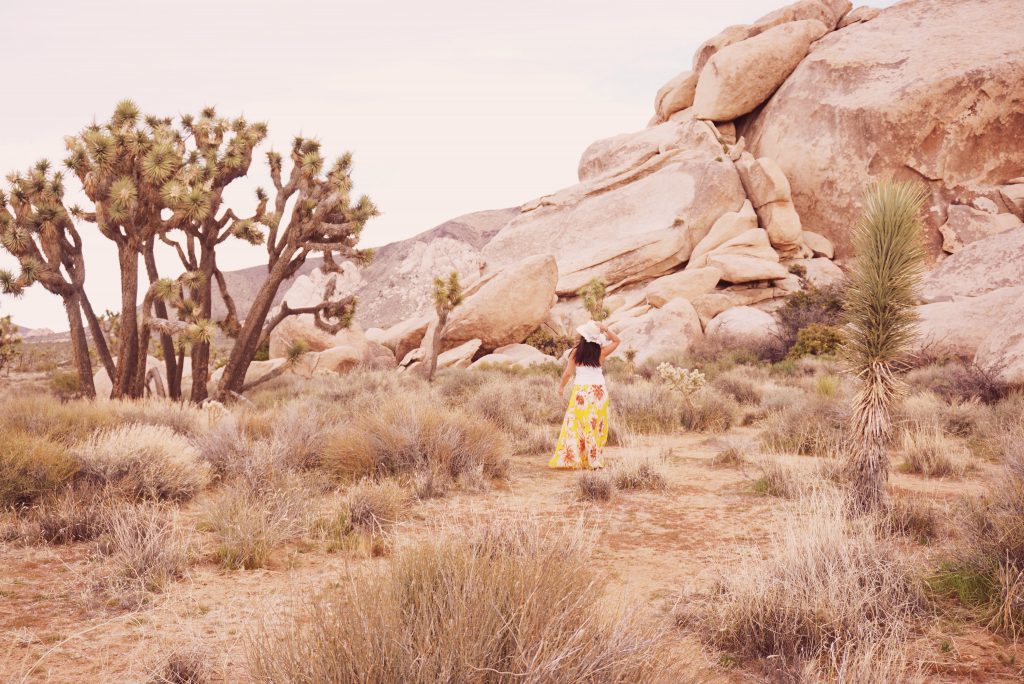
Which park entrance should you use for your day trip to Joshua Tree?
There are three entrances to Joshua Tree National Park. Which entrance you should use largely depends on where you are coming from for your Joshua Tree day trip:
- West (Main) Entrance: Most visitors from Los Angeles/San Diego/Palm Springs will opt to use this entrance. This entrance is the park’s main entrance and comes through from the town of Joshua Tree on Highway 62 at Park Blvd. If using this entrance, you must pay for your park fees (or have an annual national parks pass) at the visitor’s center before entering the park itself! Do note that this entrance can get busy, so get here early to avoid lines or bring a bit of patience lol.
- North Entrance: This entrance sits further on Highway 62, from the town of Twentynine Palms. This is the best entrance for visitors coming from destinations in the north (i.e. Las Vegas). However, during busy times (i.e. weekends and holidays), park-goers coming from Southern California may opt to use the North Entrance because it usually has far shorter lines than the West Entrance.
- South Entrance: This entrance is located just off the Interstate 10, just east of Indio, near the Cottonwood Springs area of the park. The South Entrance is an ideal access point for those coming from Indio and destinations east of the park (i.e. Phoenix). The road from the South Entrance will take you through the entire park.
Since we followed the Google driving directions from Orange County, we used the West Entrance to enter the park.
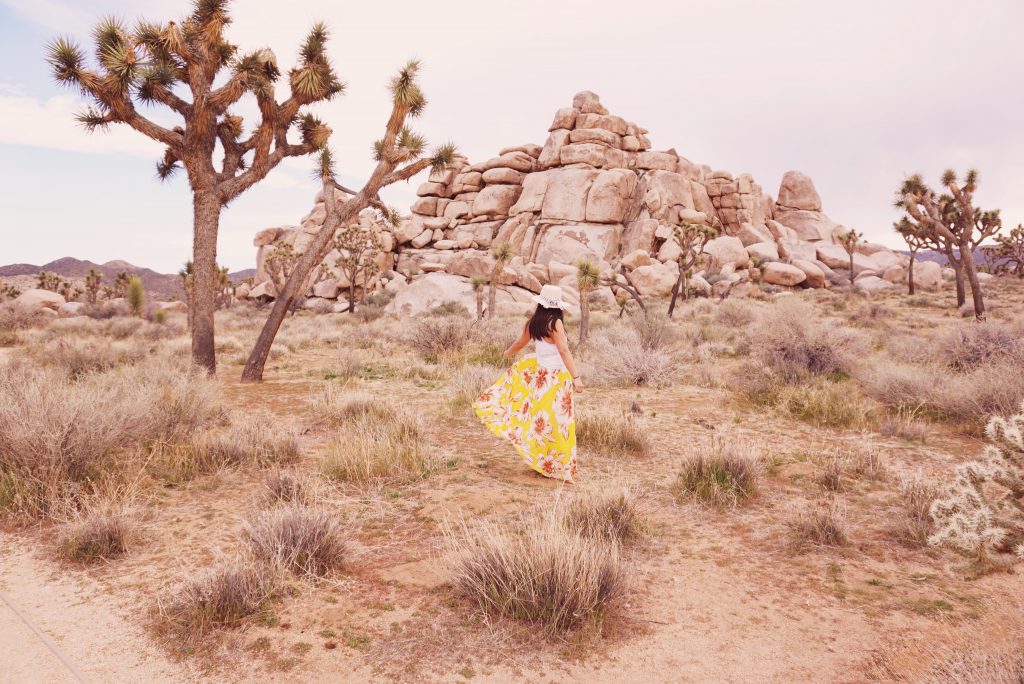
How to get around on your Joshua Tree day trip
There are no park shuttles or public transportation within the park, so you must drive to get around during your one day trip to Joshua Tree. This will allow you to see everything – besides, the roads within the park are so scenic that it is the ideal way to see it all!
If you need to rent a car, I suggest searching on rentalcars.com. You don’t necessarily need a 4×4 – while there are a few roads only accessible to 4x4s, you probably won’t have time to explore them if you’re trying to see Joshua Tree in a day.
There are two main park roads that will get you to all the highlights when visiting Joshua Tree in a day, making it super easy to get around (unlike in Olympic National Park). Park Boulevard runs from the West Entrance, near the town of Joshua Tree, to the North Entrance, near Twentynine Palms. Pinto Basin Road, which runs north-south from the park’s South Entrance and connects to Park Boulevard in the north.
There are a few other park roads that connect with the main roads, such as Keys View Road, which connects Keys View to Park Boulevard.
If you have an off-highway vehicle, you can drive along the dirt roads at Queen Valley Road and Bighorn Pass Road. Off-roading in other areas of the park is prohibited.
Do note that cell reception in the park is spotty to non-existent, so be sure to download offline maps before you arrive!
Guided Tours to Joshua Tree National Park
If you wish to visit Joshua Tree National Park without a car, or just don’t want to deal with the hassle of driving, your best option is to visit on a guided tour.
I still recommend driving yourself (as this provides much more flexibility to see and do what you want, whenever you want), but here are some suggestions for highly-rated tour options:
- Joshua Tree Driving Tour: This 4.5-hour van tour leaves from Palm Desert, near Palm Springs, and includes stops at some of the park’s most popular sights, including Hidden Valley and Keys View. You also have the option of doing two nature hikes. This tour is the perfect for first-time visitors looking to get a great introduction to the park.
- Joshua Tree Jeep Tour: This 4-hour tour takes you through the park in a Jeep, allowing you to access some areas of the park that you wouldn’t be able to reach on a regular two-wheel drive vehicle. You will get to see the park’s highlights, as well as go off-roading on one of the dirt roads for an exciting adventure! Snacks and water are also included, so you don’t have to worry about carrying your own.

Joshua Tree National Park Day Trip Packing List
It is important to be prepared for all situations when planning your day trip to Joshua Tree National Park! The desert climate can be harsh and forgiving, so having all the right gear is important.
Be sure to add the following items to your packing list for your one day trip to Joshua Tree:
- A jacket: The temperatures can drop quickly, so be sure to dress and layers and pack a jacket. A packable windbreaker like this one is ideal for the warmer months, and a packable puffer like this one is great for cooler weather (and can be worn as a layer underneath a thick winter coat when the temperatures approach freezing).
- Good shoes: I wore sneakers and they were fine for most of the trip, but there were some trails that required climbing over rocks and I wished I had my hiking shoes instead.
- Day Pack: For holding all your gear, snacks, camera equipment, and more on your one day in Joshua Tree. You can also get a hydration pack to hold your essentials and for easy access to your water (super convenient since it can get hot).
- Water: And speaking of water…carry plenty of it on your Joshua Tree day trip! You want to have more water than you think is necessary (minimum one gallon per person, per day), especially in the summer months! I carry this water bottle with me everywhere I go, and I love it for hiking because it’s insulated and the water stays cold. It also comes in a variety of sizes to suit your needs.
- Electrolytes: This will help your body replace the salt it loses by sweating so much. I swear by Liquid IV!
- Flashlight or Lantern: Especially if you plan to hike around sunset – you don’t want to be caught in complete darkness! My friend Christina brought along this handy collapsible lantern on our trip to Zion, and I loved it so much that I had to get one for myself.
- Battery Pack: I never travel anywhere or hike without this one. It can charge up to five times on one full charge!
- First Aid Kit: Be prepared, just in case! This one is compact but has all the essentials.
- Sunscreen: The sun can be brutal here! This is my favorite, free of harmful chemicals. I also love this face sunscreen, and carry this for touch ups.
- Hat: The sun can get super harsh, so I highly recommend having a hat. A straw hat like this one not only keeps the sun out of your eyes, but also looks cute in photos (this one is another favorite for photos!), but a standard baseball cap will also do.
- Sunglasses: It can get BRIGHT! Grab a polarized pair – I love the ones from Goodr, as they’re also cute and affordable!
- Compass: Cell reception is spotty (at best) in the park so you likely will not be able to rely on GPS to get around – having a compass is a good idea to help you navigate.
- Camera: The park is so beautiful that you’ll snap tons and tons of photos! A phone camera will do, but consider bringing a dSLR for upgraded images. The Sony a6000 is my favorite travel camera!
- Food + Snacks: There is no food sold inside the park, so you’ll have to bring your own! I always have some protein bars on hand to fuel me up – these Think bars are my favorite! Pack a lunch as well!
Other Things to Know For Your One Day Trip to Joshua Tree National Park

Park Entrance Fees
As with most other U.S. National Parks, entrance to Joshua Tree National Park costs $35 per vehicle. Your admission is valid for up to seven days.
If you are planning to visit other parks, I highly recommend purchasing an annual America the Beautiful pass. At $80, this is absolutely a steal – you only need to visit three parks for it to pay for itself!
Other parks you could visit as part of a California National Parks road trip which includes Death Valley, Yosemite, Sequoia, and Kings Canyon; or as part of a Southwest road trip, which may include stops in Zion, Grand Canyon, and Bryce Canyon. The possibilities are endless!
You can purchase the pass at the park, online, or at REI.
Bring your own food
There is no food sold inside the park – you must either come prepared with your own food and snacks, or exit the park and eat in one of the surrounding towns (Joshua Tree or Twentynine Palms).
There is also a cafe at the main visitors center on Park Boulevard in Joshua Tree, just outside the West Entrance of the park.
We brought our own sandwiches and plenty of snacks – there are many picnic areas in the park where you can take a lunch break. I also carried a bunch of protein bars in my bag to keep us going on our 1 day in Joshua Tree.
Bring plenty of water (Important!)
Potable water is only available at the West Entrance station, the Oasis Visitors Center in Twentynine Palms, outside the North Entrance of the park; the Cottonwood Visitors Center, near the South Entrance; at the Black Rock and Cottonwood campgrounds, and at the Indian Cove ranger station.
Be prepared with your own water – and plenty of it – bring more than you think you need! This is especially important if you make your Joshua Tree day trip in the summer months as it gets extremely hot!
A good rule of thumb is one gallon of water per person. We brought two gallons of our own water and refilled our reusable water bottles. Also consider bringing some electrolyte mix (I swear by Liquid IV!) to help replace the salt in your body that’s lost by sweating so much.

Gas
There is no fuel inside the park, so make sure that your car has enough gas to drive through and out of the park before entering.
The nearest gas station to the park is at 29 Palms Gas in Twentynine Palms.
Toilets
You can find flush toilets at the various points within the park, such as the visitors centers and campgrounds. However, we found that the further you go into the park, the fewer facilities are available.
This one day in Joshua itinerary goes to the furthest point first, making its way back to the park entrance. We drove all the way from Orange County and headed to the Cholla Cactus Garden, without making any stops.
Soon after, we really, REALLY had to go but there were no bathrooms to be found…by the time we finally found one, well, things were dire. If you see a bathroom, make use of it!
Cell Reception
While there is cell service available in the park’s surrounding towns (Joshua Tree and Twentynine Palms), reception is spotty as best within the park itself (especially the further in you go).
Be prepared by downloading offline maps to your phone – this will be a lifesaver as you try to make your way around the park during your Joshua Tree day trip!
Watch your hands and feet
Be careful where you step, and what you touch – there’s danger to be found throughout the park, from the spindly needles of the Cholla Cactus to rattlesnakes that may make an appearance in the spring and summer. Watch where you’re going at all times!
Avoid flash floods
Flash floods do happen, so if the forecast looks suspect, check in with a ranger or the visitors center.
The Perfect Joshua Tree Day Trip Itinerary

A Things to Know for This One Day in Joshua Tree Itinerary
This itinerary starts from the West Entrance
We entered from the West Entrance and this itinerary was built around this. We drove to the furthest point (Cholla Cactus Garden), and started there, then retracing our steps back to the West Entrance – our intention for this was to hit Key’s View around sunset, on the way out of the park.
This itinerary will also work even if you use one of the other entrances; or if you prefer, you can do it in reverse!
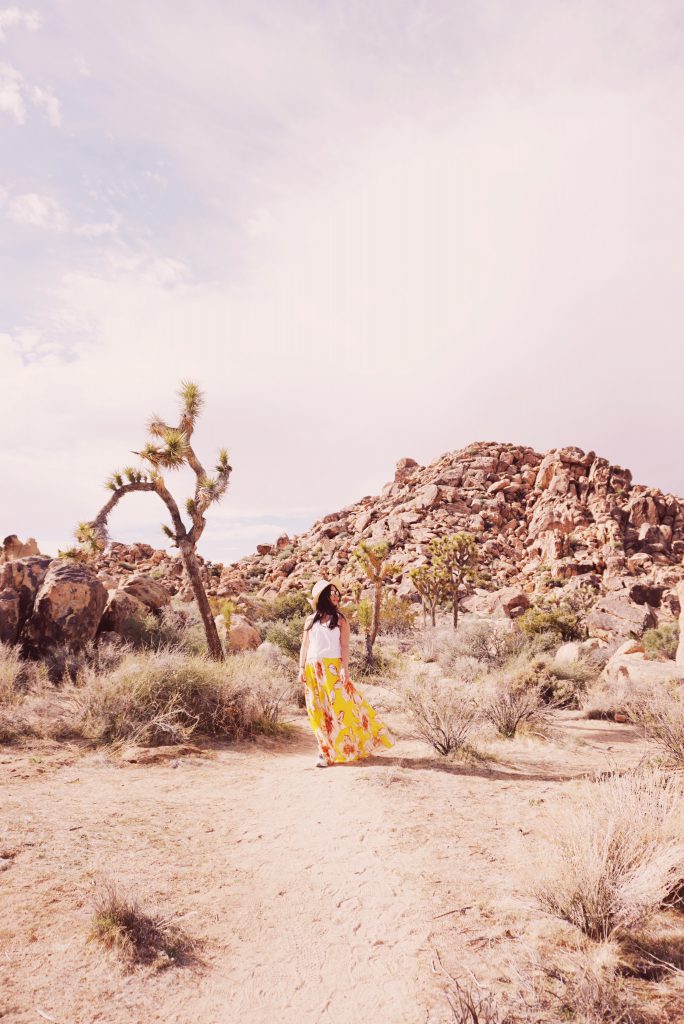

Make Plenty of Stops for Photos!
The park roads have so many scenic spots – be sure to leave plenty of time on your Joshua Tree itinerary to stop and take photos at as many as you can! There are also lots of side trails that aren’t part of the park’s main trails, as well as rock formations suitable for climbing.
We oooh- and aaah-ed our way through the park, and made plenty of stops for photos. I highly suggest you do the same! The park roads have plenty of parking areas and turnouts where you can park – however, do not park off the roads or where there is no space to park, as this is not permitted!
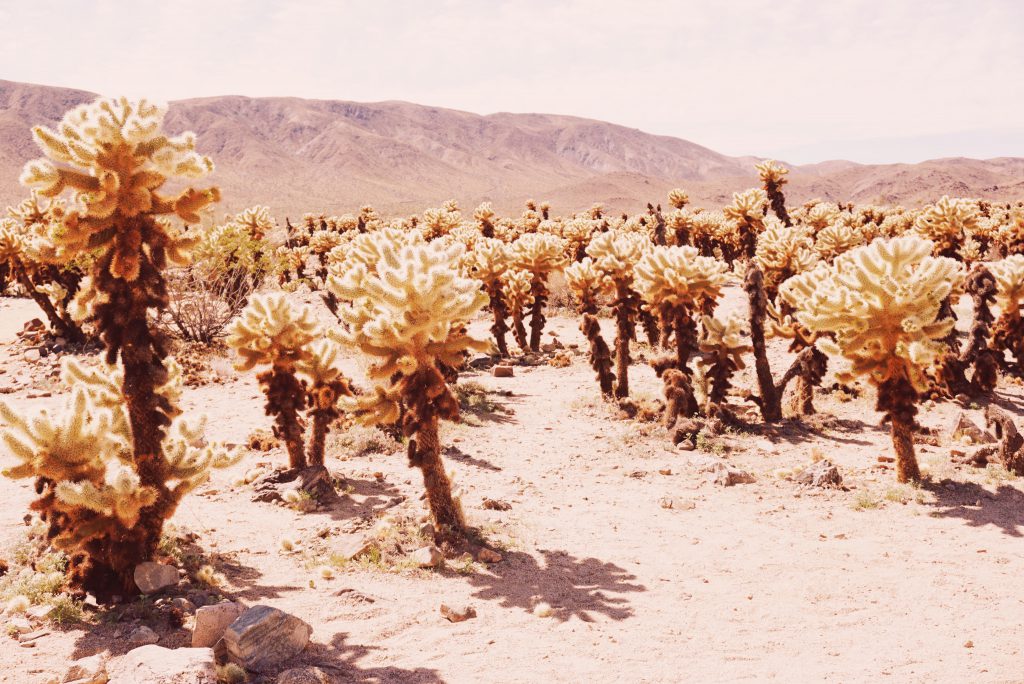
Cholla Cactus Garden
Located approximately 12 miles from the park’s main entrance (about an hour drive) is the Cholla Cactus Garden, home to the teddy bear cholla. This unusual species of cacti is unique to the Pinto Basin, in the park’s Colorado Desert side.
There are very few places to see the teddy bear cholla in the park, but the landscape at the Cholla Cactus Garden is dominated by them. A flat 0.25 mile loop trail takes you through the 10 acre garden. It is short, easy, and beautiful and a must on your 1 day Joshua Tree itinerary.


The fuzzy teddy bear cholla are deceptively innocent-looking – be careful not to touch them or get too close to them! Visitors are cautioned that even the slightest touch can cause skin penetration, and that removal can be difficult and painful. I also ended up getting some of them caught in my skirt, and trying to get them out was super annoying.
This area of the park is especially beautiful in the spring, as you can see several varieties of wildflowers blooming next to the cholla.
The Cholla Cactus Garden is supposed to be especially beautiful at sunrise, as the golden light hits the unique plants. You’ll be able to avoid most of the crowds at this time as well.
It really is gorgeous and worth a stop on your Joshua Tree one day itinerary at any time of day, though – by the time we got there it was pushing noon and it was still beautiful, especially against the blue sky!

Arch Rock
This 0.5 mile hike takes you to a unique natural arch-shaped rock formation that almost looks like it’s defying gravity. Arch Rock is impressive, spanning almost 30 feet wide, and is one of the most Instagram-worthy spots to include on your Joshua Tree itinerary.


The trail starts at the White Rock Campground, but also connects from several other trails as well. Unless you are camping at White Rock, do not park at the campground – instead, you can find parking on the side of the road, or the Twin Tanks Backcountry Board/Arch Rock Nature Trail lot.
We found the trailhead hard to find because it is not marked clearly. Look for campsite #9 – the trail starts across from here. It can also be hard to navigate the trail itself – once you come across the Arch Rock trail sign, continue on and make a left and you should find it shortly after.


The hike is short, and you can complete it in as little as 30 minutes. There are plenty of interesting areas surrounding the trail which are fun to explore, with some cool rock formations. We spent some time scrambling over these rocks and taking photos here as well – I highly recommend you do the same!
It takes a little bit of scrambling to get up to Arch Rock itself. It is not difficult, but I recommend you wear sturdy shoes. Unless you get there early, there will probably be a few waiting their turn to get up to the main rock formation and take a photo.
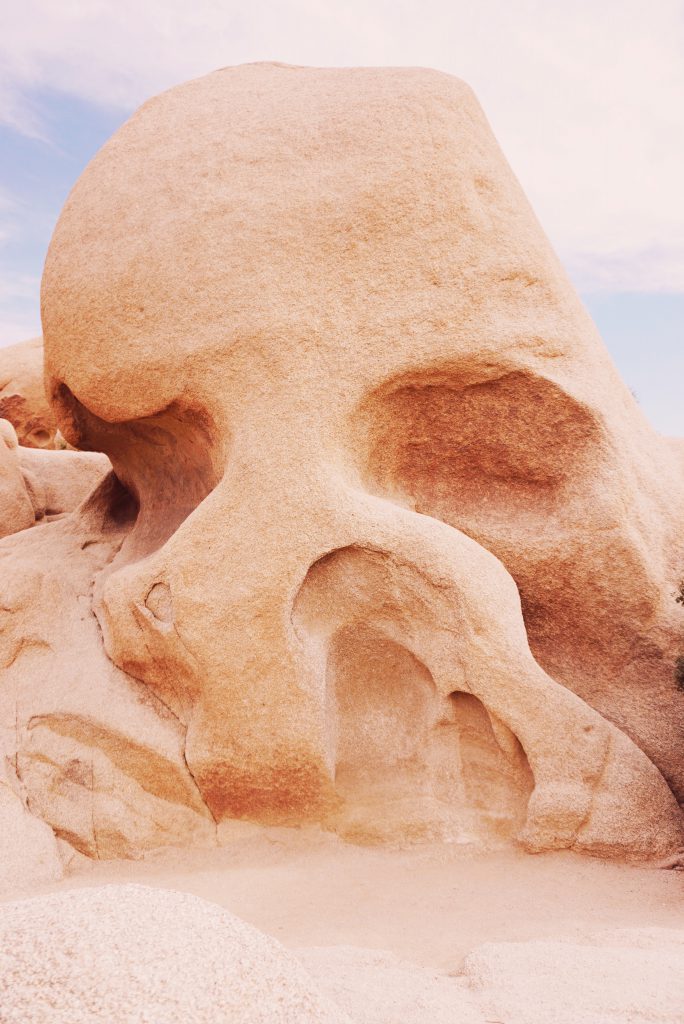
Skull Rock and Jumbo Rocks
Skull Rock is another unique rock formation that, if viewed from the right angle, looks shaped like a human skull.
The hollowed-out spots on the rock resembling eye sockets is actually a result of erosion over the years. To me, it resembled a skull when I saw it up close – it didn’t look like anything seeing it from a distance.
We saw lots of people here who were taking photos – if you want a shot of yourself on the rock itself, be prepared to wait. We had more to hit up on our Joshua Day trip itinerary, so we didn’t wait around.

There’s a parking lot right next to Skull Rock, but you can also take a stroll through the 1.7 mile Jumbo Rocks nature trail. I highly recommend it walking through at least part of it, as this area is super scenic and filled with some, well, jumbo rocks (they’re super fun to climb over!).


Hidden Valley
Hidden Valley is one of the most popular areas of the park, but is a must visit. The one-mile nature trail gives you a great overview of the varied landscapes contained within the park.

The Hidden Valley trail is sort of your signature Joshua Tree trail, introducing you to the best of what the park has to offer. The trail takes you through a scenic valley, hidden behind a narrow entrance between boulders. Because it is so hidden, it is said to have been used as a site for 19th century cattle rustlers who hid their cows here!


You will see varied plants and animal species within Hidden Valley, as well as many interesting rock formations – the area is popular with rock climbers as well. The nature trail takes you around to some of the most prominent features of the park, introducing you to the diversity of the area’s plant life and geology.
Aside from hiking through Hidden Valley, I recommend driving through the area and making stops for photos, as this is one of the most beautiful areas in the park! We definitely made a bunch of stops here on the way to our next stops on this Joshua Tree one day itinerary.
Barker Dam
Barker Dam is one of the most iconic sights in Joshua Tree and located just two miles from Hidden Valley – there is a trail connecting the two if you want to make it one bigger hike.
This is one of the most popular sights in the park, so you should expect some crowds. The 1.1 mile loop trail takes you to an old reservoir and dam constructed by early local ranchers in 1900, who built it to serve as a source of water for their cattle.
This hike is best done in the spring, when you will find a small blue lake sitting in front of the tall mounds of boulders. It is a serene oasis in the middle of the desert. Unfortunately, it was a relatively dry year when we visited and we were running behind (which might happen when trying to see Joshua Tree in a day), so we decided to skip it.

Cap Rock
Cap Rock wasn’t originally on our one day in Joshua Tree itinerary, but we stumbled upon it when I made my boyfriend pull over because I wanted to take some photos. When he tried to find parking, we ended up parking at the trailhead for Cap Rock, and well, since we were already there…
Cap Rock is a short 0.4-mile loop trail that takes you around to some interesting boulders. It is flat, easy, and well-marked trail, making it an ideal choice for hikers of all ages and abilities.


The trail starts at Cap Rock, the name given to the outcropping of boulders topped by a balanced rock slab (like it’s wearing a cap!). It is also a popular spot for rock climbers – chances are, you will see some of them trying to climb up the rocks and crags in the area.
There were lots of interesting plant species and wildflowers blooming around the trail here, and interpretive signs will point out each of the species to you. You will see a spectacular array of desert shrubs, as well as juniper woodlands, which make use of the mircohabitats created by the shade from the boulders.


It is an especially beautiful trail to explore during the spring months – bonus points, we found it to be not very crowded either, even though we were visiting during the peak season!
This is also one of those areas that have the signature Joshua Tree landscapes, and is another great introduction to the park.

Keys View
I loved the view from Keys View on my first trip to Joshua Tree, and since then I always wanted to return for sunset. We planned our whole Joshua Tree itinerary based on the fact that we’d end up at Keys View for sunset.
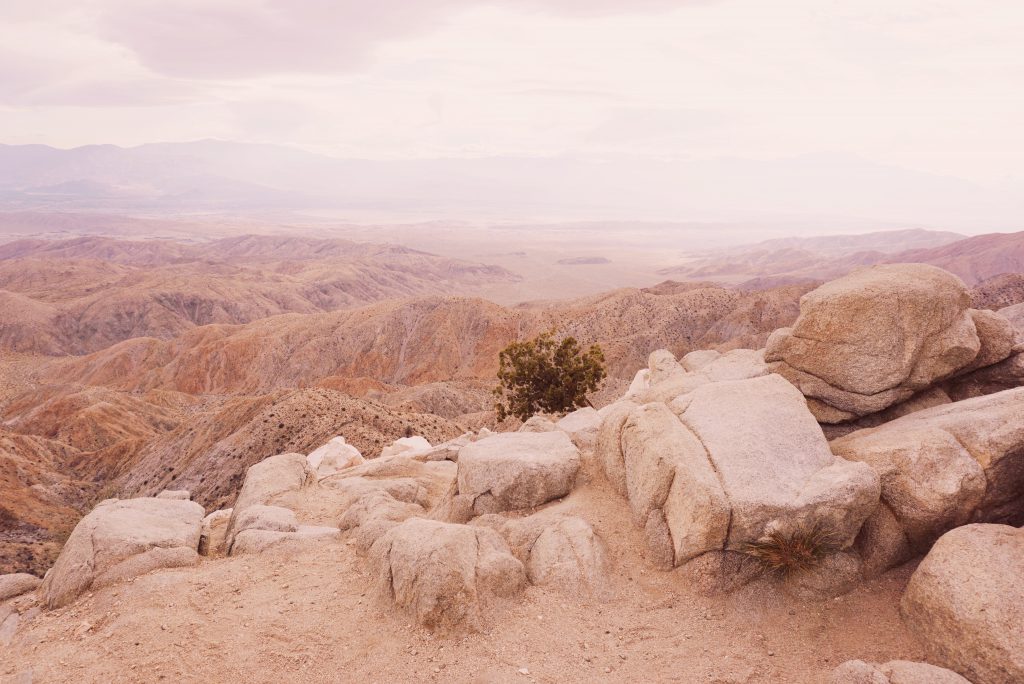
Well we didn’t quite make it to sunset, but close enough – it started getting windy, chilly, and overcast, so we knew we wouldn’t be getting much of a sunset. But even with the overcast sky, there were still some light rays streaming through the clouds, which made for a magical sight, and was the perfect way to end our Joshua Tree day trip.
Standing at 5185 feet in elevation, Keys View is Joshua Tree’s highest viewpoint, and offers sweeping vistas of the Coachella Valley, Palm Springs, Mt. San Jacinto, Mt. Gorgonio, the Salton Sea, the San Andreas fault, and beyond.
On a clear day, you can see all the way into Mexico! Chances are, you’ll encounter all that So-Cal smog that prevents you from seeing that far, but it is still an impressive view of the desert, the valley, and the surrounding peaks.
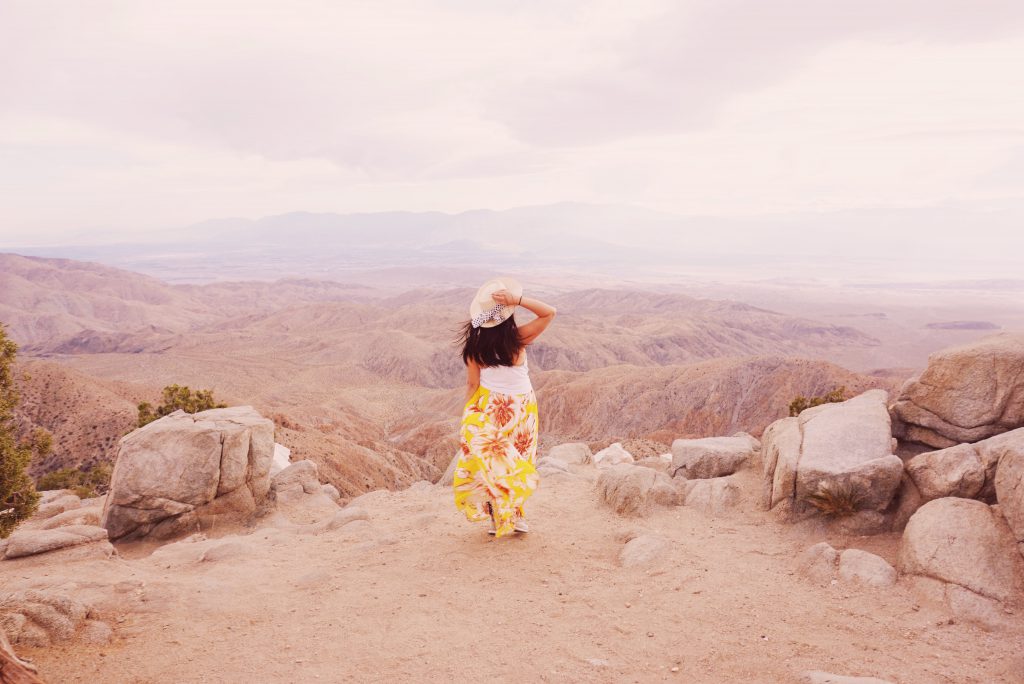
I was mostly blown away by the colors of the mountains, and seeing the layered hills – an absolutely spectacular sight! A stop at Keys View is a must on your one day in Joshua Tree itinerary for this reason.
As it is at one of the highest points in the park, expect cooler temperatures at Keys View – plan accordingly and bring a jacket. It also gets windy AF here – I definitely had to hold my hat down!
Other Things to Do and See on Your Joshua Tree Day Trip
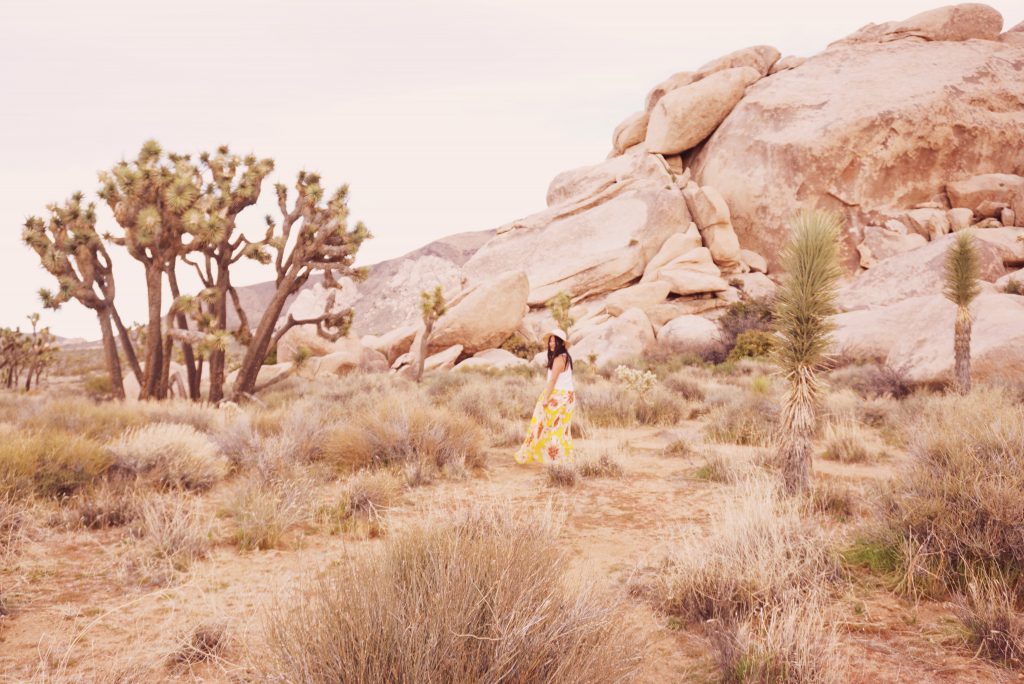
If you find yourself with extra time on your day trip to Joshua Tree or want more options, considering adding one of these spots to your itinerary:
Ryan Mountain
Hikers looking for more of a challenge may consider adding Ryan Mountain on their Joshua Tree itinerary. This short but challenging hike climbs 1050 feet in 1.5 miles, taking hikers to the 5457-foot summit of Ryan Mountain.
If you choose to hike Ryan Mountain, you will be rewarded with impressive panoramic views of the jumbled rock formations and Joshua tree forests down below. As Ryan Mountain sits right in the middle of the park, it is the best spot to get the perfect top-down view of the surrounding landscape.
The hike is strenuous and the trail is in full sun, so it is not recommended during the summer months.
Lost Horse Mine
Long before the California Gold Rush, prospectors were already finding gold in Southern California. At one point, there were over 300 mines within the area that is now Joshua Tree National Park; because of the harsh desert conditions, few produced very much gold, but the exception was the Lost Horse Mine, which produced 10,000 ounces of gold and 16,000 ounces of silver between 1894 and 1931.
You can hike to the mine in a 4-mile hike that starts just off Keys View Road. The Lost Mine hike is moderate in difficulty, with 550 feet in elevation gain, and takes 2-3 hours to complete. Hikers who are looking for a longer hike can also visit the mine as part of the Lost Horse loop, which is 6.5 miles and takes 4-6 hours to complete.
Stargazing in Joshua Tree National Park
Joshua Tree is famous for its stargazing opportunities (it’s been certified as a Dark Sky Park by the International Dark-Sky Association), and if you are considering extending to an overnight trip, well, this is it.
You can see the stars in the sky from basically anywhere in the park – just park at one of the pullouts off the road, and look up into the sky. For a more interesting view, try star gazing from one of the interesting rock formations in the park, such as Arch Rock, Skull Rock, or Cap Rock.
If you are camping in the park, you can see the stars from any of the park’s campgrounds, but Cottonwood Springs has the darkest skies.
More information on tips on stargazing in Joshua Tree here.

Where to Stay in Joshua Tree National Park
Want somewhere to crash after your one day in Joshua Tree National Park? The park has nine campgrounds, and hotel rooms and vacation rental properties are available in its surrounding towns, Joshua Tree, Twentynine Palms, and Yucca Valley.
Staying overnight in Joshua Tree can help you plan your one day in Joshua Tree itinerary more efficiently, as it will help you get an earlier start to your day! Or, you can get some rest after a busy day of exploring the park.
Below are your options for where to stay in/near Joshua Tree National Park:
Camping in Joshua Tree National Park
Joshua Tree National Park has nine campgrounds, with over 500 campsites within the park. During the summer months (May-September), campsites are first-come, first-serve; some campsites are also closed. There are no camping reservations accepted during these months.
For the months of October-April, these campgrounds accept reservations:
- Black Rock
- Cottonwood Springs
- Indian Cove
- Jumbo Rocks
You can book campsites on the Recreation.gov site. Do note that campsites book up weeks, and often months in advance, so reserve as soon as possible!
The remaining campgrounds are on a first-come, first-served basis year-round:
- Belle
- Hidden Valley
- Ryan
- White Tank
Couldn’t reserve a campsite, and had no luck with the first-come, first-served campgrounds? The NPS suggests some options here, including camping on public land managed by the Bureau of Land Management.

Hotels Near Joshua Tree National Park
You will find an array of hotel options near the park, ranging from chain hotels to independent boutique hotels, at various price points.
Here are some recommended options, to suit various budgets:
- High Desert Motel: Ideal for those on a budget, this down-to-earth property is located just six miles from the entrance of the park. The comfortable but basic rooms feature a microwave and mini-fridge, and the property has an outdoor pool and picnic area as well.
- Sunnyvale Garden Suites Hotel: This Old West themed hotel is situated just four miles from the North Entrance of the park, featuring an eclectic mix of old-school and modern furnishings. There are barbeque grills on the private decks, and the property even has a game room and karaoke room.
- Joshua Tree Ranch House: This relaxed, western-inspired motel is housed in a historic 1940s building, located just a six-minute walk from the Joshua Tree visitors center and five miles from the West Entrance. The seven rooms have pine-paneled walls and retro furnishings, as well as a kitchenette. The property also has an outdoor pool and fire pit.
- Castle House Estate: This glamping experience strives to make the everyday extraordinary, and was featured on HGTV. There are several (very Instagrammable) accommodation options available, from campsites, to trailers, to a container home, and yurts! This is a top choice for those looking for a unique accommodation option.


Have you been to Joshua Tree National Park? What are some of your must-dos on a Joshua Tree day trip?
You might also like:
The Perfect Palm Springs Weekend Getaway
A Guide to Visiting the Lancaster Poppies
The Ultimate Guide to Yosemite National Park in the Fall
9 Epic Hikes in Zion National Park
Why You Need to Visit the Grand Canyon North Rim
50+ Amazing National Parks Gifts
The Ultimate Los Angeles Bucket List
The Ultimate Orange County Bucket List
Like this post? Save this one day in Joshua Tree itinerary on Pinterest for later!


Caroline is a Southern California based traveler, writer, and photographer. She travels all around California, the US, and the world in search of the most colorful places, the most delicious food, and bucket-list adventures. Her aim is to inspire other travelers discover how to add more adventure and joy to their lives. On Pictures & Words, you’ll find detailed guides + itineraries, along with vibrant photos to help you plan the the most epic trips. When she’s not traveling, Caroline also runs half marathons.

Anna
Sunday 13th of September 2020
I've wanted to visit Joshua tree for a while now - this post (and your beautiful imagery) have confirmed that for me!
sam
Sunday 13th of September 2020
Great informative post! Looks like such a fun place to explore and amazing how you can get such different landscapes not too far out of LA!
Rachael Brown
Saturday 12th of September 2020
I love Joshua Tree! It has such a unique landscape. Thanks for the awesome guide, I'd love to return one day
Krista
Saturday 12th of September 2020
This looks like such a nice place to spend the day, and your photos are amazing!
Marika
Saturday 12th of September 2020
I absolutely LOVE Joshua Tree! There is a lot I haven't explored and based on your post I definitely missed out! I will have to go back and stay at one of those cool AirBnBs.